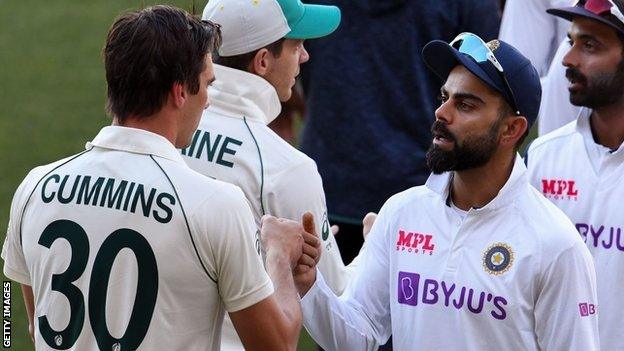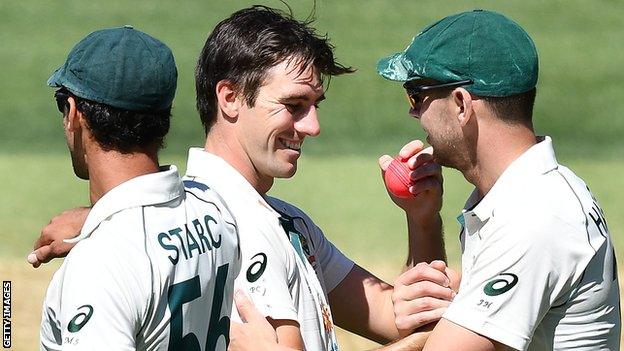Australia v India: How Virat Kohli's side were skittled for 36
- Published

India's Virat Kohli looked shellshocked after his side's collapse
In the hallway of the broadcast area of Adelaide Oval straight after play, former Australia Test bowler Damien Fleming was wide-eyed.
"I see it, I see 36, but I don't believe it," he said. "It's insane. The last time I saw that would have been under-12s."
His disbelief is understandable. How does a team - the modern, professional India team from the world's most famously cricket-mad country - get skittled in a Test match for 36?
Test cricket's momentous episodes come at you fast. Even faster in contrast to the mostly slow and daydreaming passages of play from which they are born.
Yet the Adelaide Test of 2020 had not been slow, careering through its first two days and nights at the pace some white-ball matches develop. But even so, the third innings being completed in 21.2 overs was an acceleration that nobody saw coming.
If you are watching the start of a day's play and the nightwatchman gets out, that's no big deal. Another wicket a few overs later is significant - the obdurate number three removed for a duck - but that's not unusual.
The remaining opener gets a nick the following over.
It's 15-4, but you tell yourself the score looks worse because it includes the promoted tailender. The next pair will adapt their approach and settle into some sort of a rebuild, you think. They should at least get the score to 60 or 70 and get things going.
Except they don't. Another wicket falls on the same score as the previous three, the team's vice-captain feathering a catch behind.
The skipper hits a defiant boundary but then gets caught in the gully.
The tail is not much chop, the side is 19-6, and all of a sudden you realise the lowest score in Test history, external is in play.
India's players avoided the indignity of crumbling for fewer than 26, but didn't go much better, setting a new low score for their country.

Mitchell Starc, Pat Cummins and Josh Hazlewood have been touted as Australia's greatest ever pace attack
"It was staggering, you could not quite believe your eyes at the speed at which it was happening," reflected commentator Alison Mitchell.
"First of all four wickets for no run, then five for four in 35 balls, the innings unravelling. We've all seen collapses around the world, but this just happened so quickly, in the blink of an eye."
The feeling around the ground was one of disbelief. This year's pandemic-affected Adelaide Oval was different to previous years: the crowd more sparse, more spaced out, no sign of the usual social areas outside the seating bowl.
The bays of India supporters had brought most of the noise. Abruptly, they became extremely quiet. Virat Kohli's boundary got a cheer, but there was the sense by then that everyone was swept up in the inevitability of India's demise.
Even from Australia supporters, the last few wickets didn't so much bring cheers of celebration but more sedate noises of affirmation: of course they were out. Everyone gets out today.
People will naturally speculate whether the playing surface was a minefield. It wasn't.
It's true there was longer grass than previous years, in response to David Warner's 335 not out a year ago.
Before the match, when I asked head groundsman Damien Hough if that would mean more movement, he smiled knowingly and said: "I hope so."
But his pitch was ideal: there was pace and lift, some sideways movement, and that was it.
"It wasn't excessive," said Fleming. "But they didn't bowl a bad ball. And India's bowlers could rightly feel like 'what have we done?' I wouldn't have wanted to see Australia chasing 180 on that."
It came down to the quality of the bowlers. The ABC's lead commentator Jim Maxwell, having seen six decades of cricket at first hand, was fulsome in his praise.
"I think those Australian pace bowlers are arguably the finest trio we've ever had, in terms of their ability to strike," he told the BBC. "It was a remarkably skilful performance on a pitch that offered just enough.
"You only have to look at the strike rates of Pat Cummins, Mitchell Starc and Josh Hazlewood to realise when they're on, they're going to do things like that. A bit of assistance, that's all it needs with bowlers of that skill.
"We've seen it with Trent Bridge and Stuart Broad, if you get on a roll. As we all know, the most difficult time to bat is when you're on nought."

India supporters had very little to cheer after the opening minutes of the third day of the first Test at Adelaide
Mitchell saw things similarly. "The bowling was first class. Most of the wickets were to vertical-bat shots. It wasn't as though the batsmen were slogging or chasing wide deliveries," she said.
Really the only dismissals that suggested batsman error were Kohli chasing a wide ball, and wicketkeeper Wriddhiman Saha flicking airborne to mid-wicket.
Otherwise, Cummins and Hazlewood shared nine wickets between them by smart bowling. There were no miracle balls jagging back a mile. There were short balls to discomfort the lower order, but everything else just hit the right length, banging down on the seam, and making it move a little.
Just a little, for Cummins to deck away from Cheteshwar Pujara's chamois-soft defence. Just a little for Hazlewood's first ball of the innings to nick off Mayank Agarwal. Just a little for Ajinkya Rahane to be drawn into a shot by shape in the air.
An edge first ball for Ravichandran Ashwin, another for Hanuma Vihari and Hazlewood finished with figures of 5-8. Cummins ended with 4-21, being denied the chance of a fifth only by forcing Mohammed Shami to retire hurt.
For Maxwell, it's also part of a revolution at Adelaide, with greenery required for pink-ball matches at what used to be a venue for big runs. "We associate three-day Test matches in Australia with every other ground but this place," he said.
"We've now seen the two quickest Test matches ever played on this ground, and both in pink-ball Test matches in recent years. The first one in 2015, and this one was quicker.
"That does say something about the format. And the change in this pitch from the old days, where there were many timeless Tests played on this ground.
"It will be an interesting discussion next time India come to Australia about whether they'll want to play another."
Equally interesting might be how England's team will feel about an Ashes day-nighter in Adelaide one year from now.
Watching India's fate from afar might be unnerving, but the pink-ball match was the most competitive on the previous visit in 2017, suiting England's bowlers. No-one has a monopoly on movement at pace, it's just about who can harness it.

Documentaries Like Nowhere Else: From inspiration to infamous, the story of Lance Armstrong
Comedy Like Nowhere Else: Give Kurupt FM a go with the People Just Do Nothing box set
